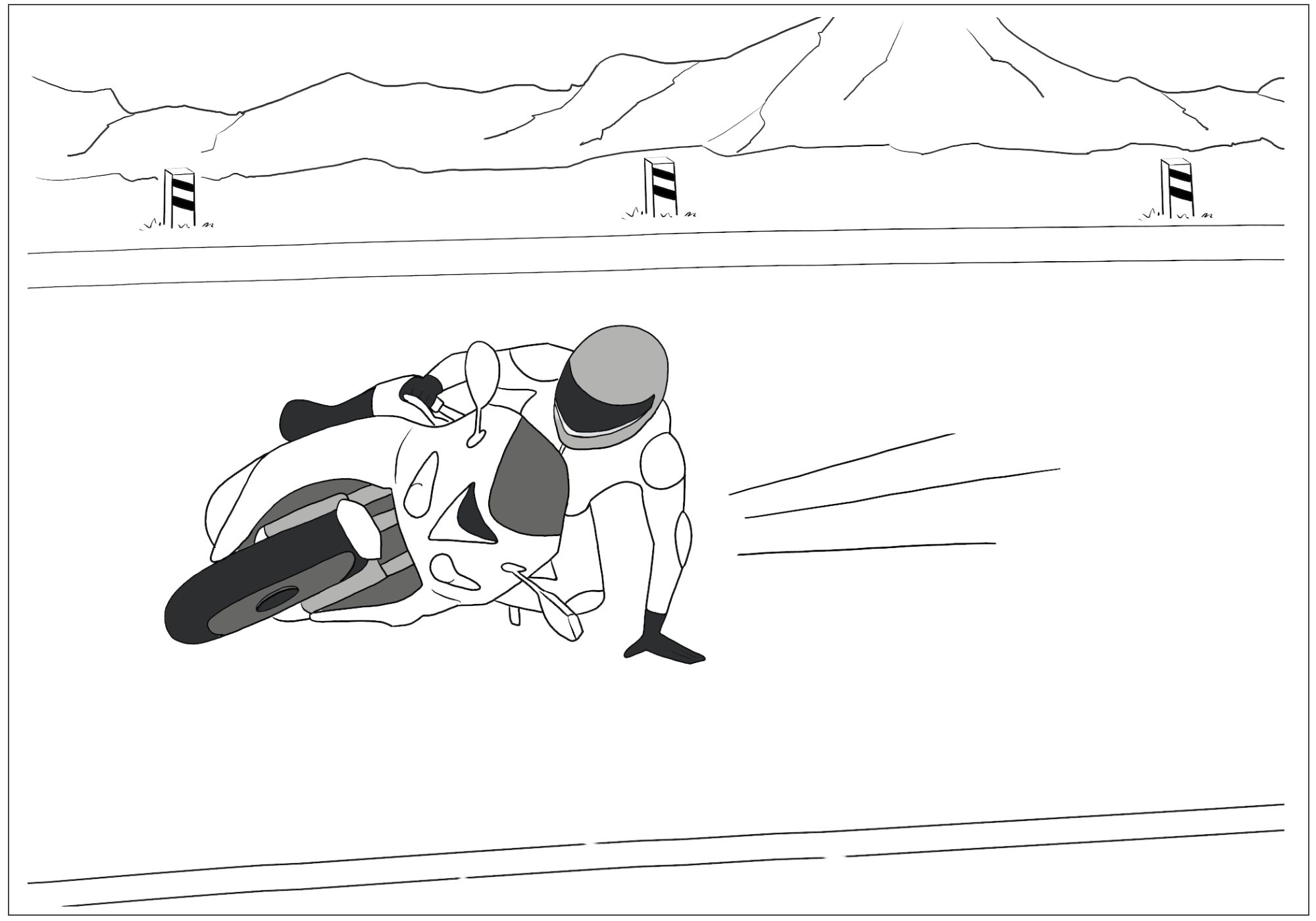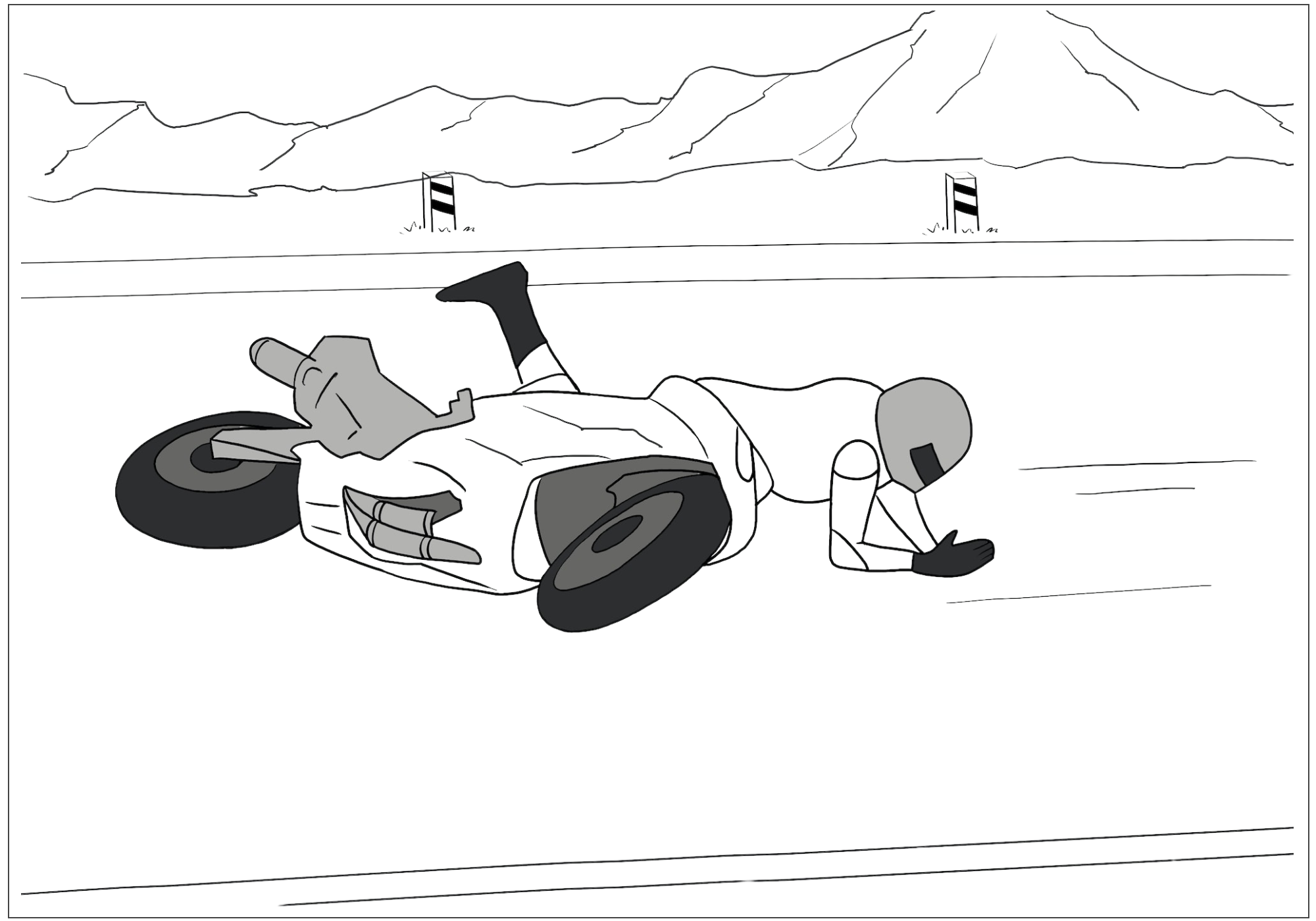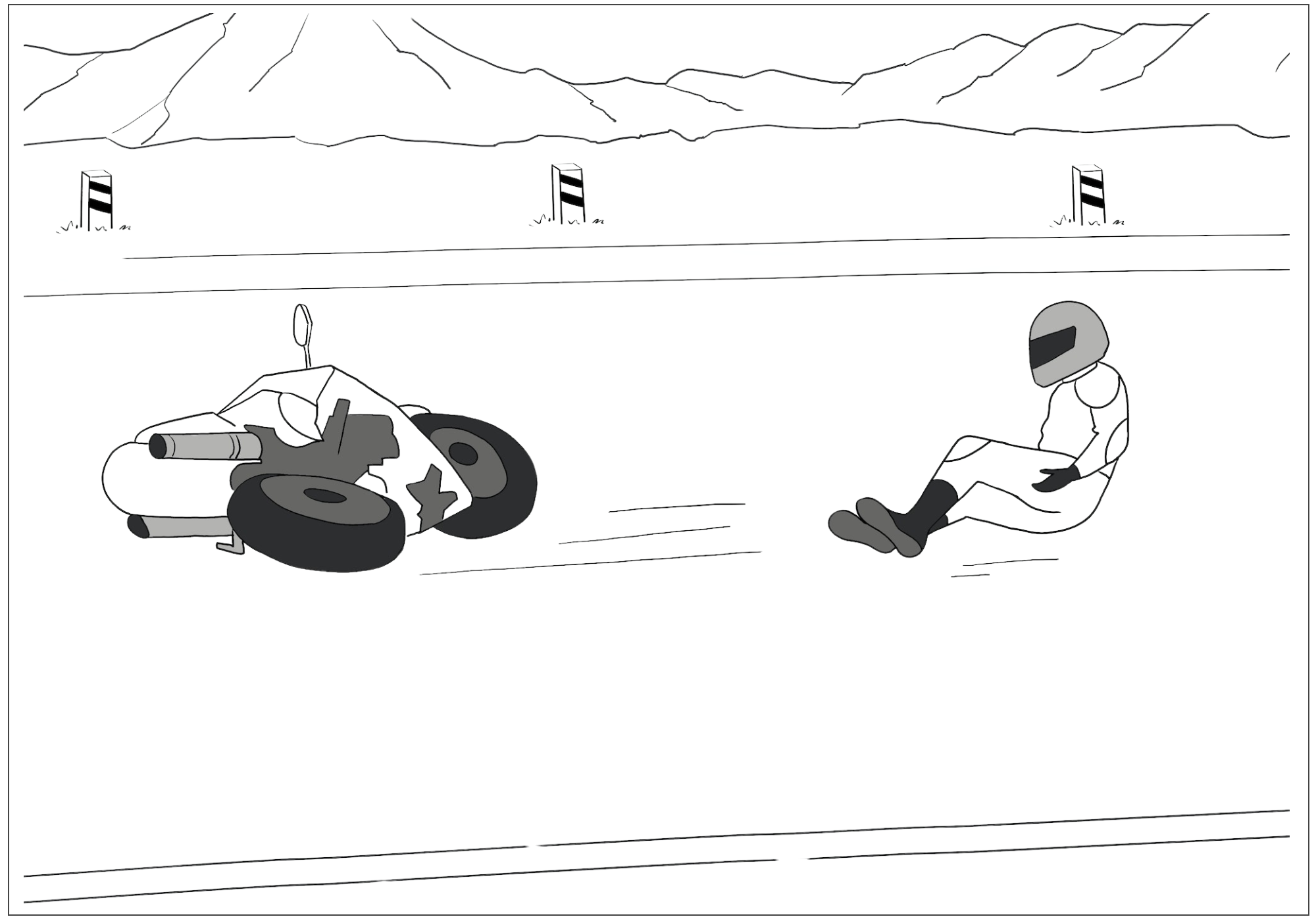Lowside Crashes: Understanding and Preventing Rider-Induced Lowside Crashes
written by David Mixson
While this article focuses on lowside crashes, understanding highside crashes is just as important because they’re related. Be sure to read Highside Crashes: Understanding and Preventing Rider-Induced Highside Crashes after reading this. Understanding lowsides and highsides is a package deal. Knowledge of one without the other is like serving salt without pepper.
What Is a Lowside Crash?
A lowside crash is when your motorcycle loses stability control, falls on its side sliding, and dumps you (the rider) on the ground behind it. Some refer to a lowside as a “slide-out” because that’s sort of what happens—your rear end slides out. Figure 1 (below) shows a rider who has just lowsided.

(Motorcycle Slides Out and Dumps Rider)
Executive Summary
Nearly all lowside crashes are rider-induced crashes triggered when a rider locks up his rear tire (due to over-braking), or spins his rear tire (due to over-accelerating)—and the ONLY way to prevent this from happening is to ride a motorcycle equipped with an anti-lock braking system (ABS) and Electronic Stability Control (ESC). I’ll go into more details below (and in other articles), but I wanted to make that point as quickly as possible so someone can’t miss it.
A Frame-by-Frame Analysis
The illustrations below are from a real lowside crash captured on video.
In Figure 2 (below), both tires are in rotational contact with the ground. Everything is working as it should.

(Riding Around a Curve Just Fine)
In Figure 3 (below), the rider locks up his rear tire (or over-accelerates and spins rear tire) while he’s in the curve, and his rear tire loses rotational contact with the pavement. This is the beginning of a lowside.

(Rear Tire Loses Traction)
In Figure 4 (below), the rear tire starts sliding around. The rider panics and puts his hand down—which won’t help him keep from crashing.

(Rear Tire Slides Out)
In Figure 5 (below), the motorcycle slides and dumps the rider.

(Bike on Side and Rider Dumped)
In Figure 6 (below), the rider and motorcycle continue sliding. How far each one slides depends on how fast the rider was going, and how easily the bike and rider slide on the ground. See the video examples below.

(Bike and Rider Begin the Slide)
In Figure 7 (below), the motorcycle and rider come to a stop. In this example, the rider stopped faster than his motorcycle. Good news.

(Bike and Rider Finish the Slide)
What Triggers Most Lowsides?
Now that we know what a lowside is let’s take a look at what triggers them.
NOTE: Before we go any further, it’s worth noting that a skidding tire (which has kinetic friction) has less grip than a rolling tire (which has static friction). This explains why the rear tire slides around to the path of least resistance when the rear tire loses static friction (skids/spins).
Lowside Trigger #1
Rear tire locks up (skids) due to over-braking while in a curve.
If you lock up your rear tire when you’re going around a curve, you’ll most likely lowside. When your bike is leaning over, it needs rotational control and friction between the rear tire and the pavement to keep the bike upright. See Figure 3 above for the beginning of a lowside.
Once you lose static friction (by locking the rear tire), the back tire will slide out, and the bike will fall on its side—dumping you on the ground behind it.
Lowside Trigger #2
Rear tire spins due to over-accelerating while in a curve.
If you spin your rear tire when accelerating hard in a curve (bike is leaned over), you’ll most likely lowside because a slipping tire has less friction than a tire in rotational contact with the pavement. Once the rear tire starts slipping, the back end will slide out, and you’ll lowside.
Less Common Triggers
I explained two additional triggers in Motorcycle Smarts. They’re less common, so I’ll only mention them here: (1) locking up your front tire in a curve, and (2) locking up (or skidding) your rear tire while going straight.
I’ll make this point one more time.
Nearly all lowside crashes are rider-induced crashes triggered when a rider locks up his rear tire (due to over-braking), or spins his rear tire (due to over-accelerating)—and the ONLY way to prevent your rear tire from skidding or spinning is to ride a motorcycle with ABS and ESC.
Real Lowside Crashes Captured on Video
I’ve watched lots of videos on YouTube that showed riders lowside-crashing alone. In the videos below, none of the riders were badly hurt.
Note: Keep watching past the initial crash scene. Ken shows each one in slow motion part-way through each video. Those are really interesting.
Lowside Crash: Illustration One
In the video below, the rider locked up his rear tire in a curve. He also locked up his front tire briefly, but the lowside was already in progress. If his motorcycle had ABS, the system would have kept him from locking up his rear tire—regardless of how hard he applied his brakes.
In other words, ABS would have prevented this lowside crash.
Had he not locked up his rear tire, he could have pushed on his inside handlebar to tighten his turn using countersteering and continued around the curve just fine.
Lowside Crash: Illustration Two
In the video below, the rider was going a lot faster when he lowsided. Speed equates to more energy that has to be dissipated before the lowside is completed. Wait until I show you some highsides at MotoGP racing speeds.
It’s hard to know for sure, but (listening to the audio) the rider appears to have spun his rear tire by applying too much throttle.
If his motorcycle had ESC, the system would have kept him from spinning his rear tire—regardless of how hard he rolled back on the throttle.
In other words, ESC would have prevented this lowside crash.
Lowside Crash: Illustration Three
In the video below, it’s difficult to know for sure what happened. The audio suggests he might have dragged something, which allowed his rear tire to lose traction and slide out.
In either case, ABS and ESC would have helped him keep from crashing.
Lowside Crash: Illustration Four
In the video below, the slow-motion portion showed the rear tire bobbling right as the lowside began. This suggests the rider spun his rear tire by applying too much throttle.
If his motorcycle had ESC, the system would have kept him from spinning his rear tire—regardless of how hard he rolled back on the throttle.
In other words, ESC would have prevented this crash.
Lowside Crash: Illustration Five
In the video below, the rider lowsided. You be the judge of what triggered the crash—skidding his rear tire by over-braking, or spinning his rear tire by over-accelerating. The beauty is that it doesn’t really matter.
In other words, ABS and ESC would have prevented this lowside crash.
In all of the lowside crashes shown above, ABS and ESC could have saved the day. That’s why these two pieces of electronics should be Federally mandated for all on-street motorcycles sold in the U.S.
It Happened So Fast
In my first edition of Motorcycle Smarts, I wrote that I had never lowsided but that I had spoken to several riders who had. All of them said it happened really fast. In the blink of an eye, they went from (everything is fine) to (my bike is sliding, and I’m sliding behind it).
When I published the second edition, I added this update:
I lowsided on a Backcountry Discovery Route in the George Washington National Forest in Virginia a few years later. The dirt road was a muddy mess. Unfortunately, my bike slid down a 10-foot embankment. As my bike went over the cliff, I thought, “We’ll never get it out of there.” Two hours later, my riding buddy, Mike, and I manhandled it up the embankment—only because we didn’t have another option. Right as we did, a group came along, and two of the riders lowsided in the exact same spot. They were both shaken up a bit—as I was.
Yes, it happened incredibly fast!
NOTE: Traction Control is an electronic component that’s a simplified version of Electronic Stability Control. I explain ABS, ESC, and Traction Control here.
On a personal note, I’d like to thank Ken Snyder for the videos I used above. I scoured hundreds (maybe thousands) of crash videos on YouTube to show lowside and highside crashes, and his videos are the best. You can find all of his videos here.
NOTE: I’ve never (knowingly) watched a video on YouTube that shows a rider being seriously injured or killed. That does me no good, and I think it’s disrespectful to the rider and their family. But YouTube can be a great tool if used properly—because there’s usually a lesson buried in every motorcycle crash.
* This article has excerpts from my books Motorcycle Smarts and Motorcycle Hacks.
Read Next
David Mixson writes about the topics other motorcycle books gloss over. He worked as a NASA engineer for over thirty years and is the author of three books.

We hate SPAM too.
Unsubscribe at any time.

